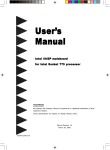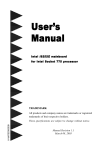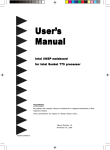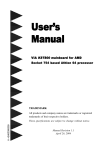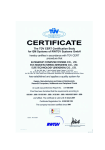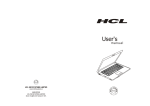Download User`s Manual
Transcript
User’s Manual Intel i915GL / i915GV mainboard for Intel Socket 775 processor TRADEMARK All products and company names are trademarks or registered trademarks of their respective holders. These specifications are subject to change without notice. 60000025EGM11 Manual Revision 1.1 July 14, 2006 DISCLAIMER OF WARRANTIES: THERE ARE NO WARRANTIES WHICH EXTEND BEYOND THE DESCRIPTION ON THE FACE OF THE MANUFACTURER LIMITED WARRANTY. THE MANUFACTURER EXPRESSLY EXCLUDES ALL OTHER WARRANTIES, EXPRESS OR IMPLIED, REGARDING ITS PRODUCTS; INCLUDING ANY IMPLIED WARRANTIES OF MERCHANTABILITY, FITNESS FOR A PARTICULAR PURPOSE OR NONINFRINGEMENT. THIS DISCLAIMER OF WARRANTIES SHALL APPLY TO THE EXTENT ALLOWED UNDER LOCAL LAWS IN THE COUNTRY PURCHASED IN WHICH LOCAL LAWS DO NOT ALLOW OR LIMIT THE EXCLUSION OF THE IMPLIED WARRANTIES. ii Table of Contents Page Section 1 Introduction Package Contents ...................................................... 1- 1 Mainboard Features ................................................... 1- 2 System Block Diagram ............................................... 1- 5 Section 2 Specification Mainboard Specification ............................................ 2- 1 Section 3 Installation Mainboard Layout ..................................................... 3- 1 Easy Installation Procedure ....................................... 3- 2 CPU Insertion ............................................................. 3- 2 Jumper Settings .......................................................... 3- 4 System Memory Configuration .................................. 3- 5 VGA Expansion .......................................................... 3- 6 Device Connectors..................................................... 3- 7 Power-On/Off (Remote) .............................................. 3- 13 External Modem Ring-in Power ON and Keyboard Power ON Function (KBPO) ..................... 3- 13 ACPI S3 (Suspend To RAM) Function ...................... 3- 14 Section 4 BIOS Setup Main Menu ................................................................ 4- 1 Standard CMOS Setup ............................................... 4- 2 Advanced BIOS Features .......................................... 4- 3 Advanced Chipset Features ...................................... 4- 5 Integrated Peripherals ................................................ 4- 8 Power Management Setup ......................................... 4- 13 PNP/PCI/PCI-E Configuration .................................... 4- 16 PC Health Status ........................................................ 4- 17 iii Power BIOS Features ................................................. 4- 19 Defaults Menu ........................................................... 4- 21 Supervisor/User Password Setting ............................ 4- 22 Exit Selecting .............................................................. 4- 23 Section 5 Driver Installation Easy Driver Installation .............................................. 6- 1 Realtek Sound Manager Quick User guide ................ 6- 2 Appendix Appendix A Update Your System BIOS ......................................... A- 1 Appendix B EEPROM BIOS Remover ............................................ B- 1 iv Introduction Section 1 INTRODUCTION 1-1 Package Contents Contents Optional Items A. Mainboard H. S/PDIF Module B. User’s manual I. IEEE 1394 two ports cable C. Floppy drive cable J. Extra USB2.0 port cable D. HDD drive cable If you need the optional item, please contact your dealer for assistance. E. CD (drivers and utilities) F. I/O Shield G. S-ATA data and power cable E USER’S MANUAL B A H C D I F G J Page 1-1 Introduction 1-2 Mainboard Features Brief Introduction Intel ® Pentium® 4 processors The Pentium 4 processor is designed to deliver performance across applications and usages where end-users can truly appreciate and experience the performance. The Pentium 4 processor delivers this world-class performance for consumer enthusiasts and business professional desktop PC users as well as for entry-level workstation users. Intel adds support for Hyper-Threading Technology to the Pentium 4 processor family. HT Technology allows a single, physical Pentium 4 processor to function as two logical processor for next generation multi threaded application. For more information about all the new features the Pentium 4 delivers, check out the Intel website at http://www.intel.com Chipset This board is designed with Intel® 915GL/915GV chipset. The Intel® 915G series chipset consists of the Graphics Memory Controller Hub (GMCH) and the I/O Controller Hub (ICH6). DDR400 Supports dual channel of DDR400 memory to give you twice the memory bandwidth for greater system performance. PCI-Express (PCI-E) Next generation peripheral interface to succeed to current PCI bus for the next decade. With smaller slot size and 250MB/sec(PCI-E*1) or 4GB/sec(PCI-E*16) maximum transfer, PCI-Express overcomes PCI bus bottleneck. Ultra ATA100 The mainboard provides an Ultra ATA100 Bus Master IDE controller. This controller supports Ultra ATA100 protocols which are ideal to support demanding applications such as real-time video, multimedia, and a high performance operating system. A new IDE cable is required for Ultra ATA100. Page 1-2 Introduction Hardware Monitoring Hardware monitoring enables you to monitor various aspects of the system operation and status. This includes CPU temperature, voltage and fan speed in RPMs. 10/100 LAN (Optional) This mainboard is mounted with a ethernet LAN chipset. It allows the mainboard to connect to a local area network by means of a network hub. GbE LAN (Optional) The new Gigabit Ethernet LAN allows data transmission at 1,000 megabits per second (Mbps), which runs 10 times faster than conventional 10/100BASE-T Ethernet LANs. Serial ATA (S-ATA) Support Serial ATA, an evolutionary replacement for Parallel ATA IDE storage interface. Increases the peak data transfer speed up to 150MB/sec and allows future enhancements to the computing platform. IEEE 1394 (Optional) IEEE 1394a provides enhanced PC connectivity for consumer electronics audio/ video appliances, storage peripherals, portable devices such as digital cameras, and inter-PC communications. IEEE 1394a provides transfer rates up to 400Mbits/sec. USB2.0 A popular USB standard for plugging in peripherals with up to 480Mbps transfer speed while maintaining backward compatibility with older USB1.1 device. 8ch Delivers 8 channel audio to bring you the latest in audio realism from DVD movies and games. Perfect for your home theatre system. Page 1-3 Introduction Special Features BIOS Features: & Magic Health Reports your system hardware status for every boot-up to help detect faults early. Monitor hardware status including CPU temperature, CPU/Memory/ Chipset voltage, fan RPM speed for chassis fan, CPU fan & Power supply fan. & EZ-Boot Simply press “ESC” to select your bootable device. No more hassle to search the BIOS menu, change and re-start. & PowerBIOS Supporting a full range of overclocking setting via BIOS. Various adjustable feature include FSB/Memory frequency tweaking. H/W Features: & QuickSPDIF On board SPDIF-out connector for quick connection to multi-channel speakers. Not only removes cable cluttering but also delivers loss-free digital audio to let you enjoy DVD movies and games with crystal clear sound. Page 1-4 Introduction 1-3 System Block Diagram Page 1-5 Introduction Page 1-6 Specification Section 2 SPECIFICATION Mainboard Specification Processor ® ® Support Intel Pentium 4 5xx series processors up to 3.4+GHz in LGA775 socket with 533/800 MHz front-side system bus ® ® Support Intel Celeron D 3xx series processors up to 3.2+GHz in LGA775 socket with 533 MHz front-side system bus Support Intel 04A Platform Compatibility Guide Supports Hyper-Threading Technology See <http://www.intel.com/info/hyperthreading> for information including details on which processor support HT Technology. Chipset ® Intel 915GL or 915GV Chipset (915GL/915GV + ICH6) - with Intel GMA900 graphics Main Memory Two 184-pin DDR SDRAM DIMM sockets Support single-sided or double-sided, 2.5v DDR-333/400 DIMMs with dual channel architecture in 256Mb/512Mb/1Gb technologies Supports up to 2GB memory size Expansion Slots Two PCI connectors compliant with PCI v2.3 One PCI-E x1 connectors compliant with PCI Express 1.0a One PCI-E VGA connectors compliant with PCI Express 1.0a IDE One IDE interface (up to 2 IDE devices) with UDMA-33, ATA-66/100 support from embedded IDE controller Page 2-1 Specification USB Eight USB connectors compliant with USB2.0 from embedded USB controller (4 connectors at rear panel) S-ATA Four S-ATA ports with up to 150MBps bandwidth from ICH6 LAN 10/100Mbps Fast Ethernet with onboard Realtek RTL8100C LAN chip, or 1Gbps Fast Ethernet with onboard Realtek RTL8110S LAN chip 1394 (Optional) Two 1394a ports with up to 400Mbps bandwidth from onboard VIA VT6307 1394 controller Audio Selectable 2, 6 or 8-CH audio from onboard ALC880 High Definition audio compliant CODEC with 20-bit ADC and 24-bit DAC resolution - Support CD-In, S/PDIF-in and S/PDIF-out - Coaxial S/PDIF-out available on rear panel - Support Jack detection for fool-proof audio device installation - Rear panel audio jacks configuration: Audio Jack Color 2 channel 6 channel Light Blue Line-in Line-in Line-in Lime Line-out Front stereo-out Front stereo-out Pink Mic-in Mic-in Gray 8 channel Mic-in Side stereo-out Black Rear stereo-out Rear stereo-out Orange Center&Subwoofer Center&Subwoofer I/O Onboard Winbond W83627THF LPC bus I/O controller Legacy peripheral interface for PS/2 keyboard & mouse, FDD, Parallel, Serial, and IrDA (v1.0 compliant) Support Hardware Monitoring for fan speed monitoring, CPU/System temperature Page 2-2 Specification BIOS Flash EEPROM with Award Plug&Play BIOS Support ACPI S3 (Suspend To RAM) mode in ACPI compliant O/S Support EZ Boot for fast bootable device selection Support Magic Health for system hardware status report during system boot-up Peripheral Interfaces ) At Rear Panel PS/2 keyboard and mouse ports One Parallel (printer) port One S/PDIF-Out Coaxial jack One VGA port One RJ45 LAN connector Four USB2.0 ports Six Audio jacks ) Onboard connector and pin-header One floppy drive connector One ATA-100 IDE connector Four extra USB2.0 ports One CD-IN connector One S/PDIF-in/out connector One IR connector One Serial Port (COM1) connector Four S-ATA connectors Three Fan connectors Front Panel Controller Supports Reset & Soft-Off switches Supports HDD & Power LEDs Supports PC speaker Supports Front Panel Audio connector Page 2-3 Specification Special Features Support KBPO function – Keyboard power on, turn on the computer from keyboard Support Wake-On-LAN by PME Support USB resume in S3 Support Asynchronous clocking mode between FSB and PCI/PCI-E PowerBIOS for excellent overclocking features: - Programmable FSB output frequency with 1MHz fine tuning - Support BIOS adjustable CPU multiplier, FSB clock, DIMM frequency settings Form Factor 245mm x 244 mm Micro ATX size Page 2-4 Installation Section 3 INSTALLATION Mainboard Layout Note: Depending on the model you purchased, some components are optional and may not be available. Page 3-1 Installation Easy Installation Procedure The following must be completed before powering on your new system: 3-1. 3-2. 3-3. 3-4. CPU Installation Jumper Settings System Memory Expansion Slots 3-5. Device Connectors 3-1 CPU Installation Step 1 Carefully remove the plastic protection plate from the socket. Warning: The pins inside the CPU socket are fragile and are easily broken. Be careful not to touch them when installing the CPU. <Figure 1> <Figure 3> <Figure 2> Step 2 Open the socket by releasing the actuation lever, and press downwards at the tip shown by the arrow. Page 3-2 Step 3 Before inserting the CPU, align the CPU according to the key slots shown in the picture. Gently place the CPU into the socket and make sure it is fully seated. Installation <Figure 5> <Figure 4> Step 4 Step 5 a) Put the CPU lid on the socket, and Place the CPU cooler on top of the socket. close the socket by lowering and Press its clips down firmly until it is locking the actuation lever. completely seated in the hole. b) Apply thermal compound to the top of the CPU and into the four holes around CPU area to install the cooler as shown. Step 6 a) Rotate the clips 90 degrees to lock the CPU cooler in place. b) Plug the cooler fan power into the mainboard’s CPU fan connector. The installation is complete. <Figure 6> CAUTION: • Installing with incorrect CPU cooler and heatsink assemblies may damage the CPU. Use Intel’s thermal solution shown in the illustrations above: an active heatsink; an extruded aluminum heatsink base; and a fan attached to the top of the fin array. • Apply thermal compound or paste to the CPU to avoid CPU overheating and damage. • In accordance with Intel guidelines specifications, do not install a CPU over 20 times to avoid damaging the pins on the CPU socket. Page 3-3 Installation 3-2 Jumper Settings JCMOS: Clear CMOS data Jumper If the CMOS data becomes corrupted or you forgot the supervisor or user password, clear the CMOS data to reconfigure the system back to the default values stored in the ROM BIOS. 1 Settings: 1-2: Normal (Default) 2-3: Clear CMOS To CMOS Clear data, please follow the steps below. 1. Turn off the system. 2. Change the jumper from “1-2” to “2-3” position for a few seconds. 3. Replace the jumper back to the “1-2” position. 4. Turn on the system and hold down the <Del> key to enter BIOS setup. Page 3-4 Installation 3-3 System Memory Configuration The mainboard accommodates two 184-pin DDR DIMM sockets. • Supports up to 2.0GB of 333/400MHz DDR SDRAM. • Supports dual channel memory interface. • Supports non-ECC memory and non-Registered DIMMs only. • Supports 256Mb/512Mb/1Gb DDR technologies in x8 and x16 devices only. • SPD (Serial Presence Detect) scheme for DIMM detection support. • Supports configurations defined in the JEDEC DDR DIMM specification only. Memory configurations supported: Slot No DIMM#1 1 DIMM DS/SS DIMM#2 2 DIMMs DS/SS DS/SS DS/SS * DS - Double-sided DIMM, * SS - Single-sided DIMM NOTES: • Using non-compliant memory with higher bus speeds (overclocking) may severely compromise the integrity of the system. Memory Installation : To install, align the notch on the DIMM module with the connector. Press straight down as shown in the figure below until the white clips close and the module fits tightly into the DIMM socket. Notch Page 3-5 Installation 3-4 VGA expansion The Intel 915GL / 915GV chipset itself has a powerful on-chip VGA engine and therefore does not support expansion for PCI-E x16 VGA cards. You may connect the monitor directly to the rear I/O of this mainboard. However, as a backup VGA solution this mainboard has been cleverly designed with a PCI-E VGA slot running at PCI-E x1 bandwidth that will allow most VGA cards to operate. If you need to use a VGA card instead of the on-chip graphics, you need to remove the Intel VGA driver before you install your VGA card. To do this, enter the O/S in Safe Mode and remove the Intel GMA900 graphics driver from the Device Manager. Shutdown the system, plug in the VGA card and restart the system. The O/S will then detect the VGA card as usual. The following type of VGA cards have been tested INCOMPATIBLE with this mainboard: NVIDIA GeForce PCX5300 NVIDIA GeForce PCX5750 NVIDIA GeForce PCX5900 Page 3-6 Installation 3-5 Device Connectors The I/O back panel for this mainboard is shown below. When installing the mainboard into the computer case, use the bundled I/O shield to protect this back panel. RJ45 LAN Parallel Port PS/2 Mouse PS/2 Keyboard S/PDIF-out Coaxial Jack VGA USB2.0 x 4 ports 7.1 Audio Channel Figure 7 - I/O Ports JCPU_FAN / JPWR_FAN / JSYS_FAN: JCPU_FAN JSYS_FAN CPU/Power/Chassis Fan Power Connectors JCPU_FAN: The CPU must be kept cool by using a heatsink with fan assembly. JPWR_FAN: If you are installing an additional fan in the unit, connect to this fan connector. JPWR_FAN JSYS_FAN: The chassis fan will provide adequate airflow throughout the chassis to prevent overheating the CPU. JCPU_FAN Control Ground Sense +12V JPWR_FAN JSYS_FAN Sense Ground +12V Sense Ground +12V Page 3-7 Installation FDD: Floppy Controller Connector IDE1 FDD 34 33 40 IDE1: ATA-66/100 IDE Connector Supports up to 2 IDE devices from embedded IDE controller . When using two IDE drives, one must be set to Master mode and the other to Slave mode. Refer to your disk drive user’s manual for information about selecting the proper drive switch settings. 39 1 2 FDD 1 2 IDE1 PW1: 24-pin ATX Power Connector PW12: 4-pin ATX12V Power Connector The mainboard is equipped with a standard 24-pin ATX main power connector and a 4-pin +12V power connector for connecting an ATX12V power supply. The plugs of the power cables are designed to fit in only one orientation. Insert the plugs into the connectors until they fit in place. PW12 PW1 Caution: The PW1 and PW12 Power Connector must be used simultaneously . 23 24 3.3V Ground +12V +5V +12V +5V 5VSB 3 +12V Ground Ground Ground +5V PS-ON Ground 3.3V Ground -12V 4 +12V Ground +5V PW-OK Ground +5V 1 2 PW12 -5V Ground Ground 3.3V 3.3V 1 11 PW1 Page 3-8 The board requires a minimum of 350 Watt power supply to operate. Your system configuration (amount of memory, add-in cards, peripherals, etc.) may exceed this minimum power requirement. To ensure that adequate power, use a 400 Watt or greater power supply. Installation CFPA: Front Panel Audio Connector This audio connector connects to the audio jacks located on the front panel. Refer to your case manual to match the pin-out names. Front Line-out-R NC NC MIC_In Front Line-out-L 9 1 2 10 NC NC GND Key +5V CD-IN: CD Audio_IN Connector The CD-IN connector is used to receive audio form a CD-ROM drive, TV tuner or MPEG card. CD_Reference CD_IN_Right CD_IN_Left 1 SPDIF: Sony/Philips Digital InterFace connector This connector links digital audio between the mainboard and your audio devices, such as CD player, sampler or DAT recorder. It allows the digital transmission of audio data in S/PDIF format. SPDIF_IN VCC 5 1 6 2 NC GND SPDIF_OUT Page 3-9 Installation COM1: Serial Port Connector The serial port can be used with modems, serial printers, remote display terminals, and other serial device. RTS RI DSR CTS NC 10 2 9 1 DCD TXD Ground RXD DTR C1394-1 / C1394-2 : (Optional) IEEE 1394a (FireWire) Connectors This mainboard has 2 IEEE 1394a ports. To use these ports, you need to attach the bundled 1394 bracket to these headers. TPB+ +12V (Fused) GND TPA+ Key 9 1 10 2 GND TPA+12V (Fused) GND TPB- C1394-1C1394-2 SATA1/SATA2/SATA3/SATA4 : S-ATA Connectors These connectors enable you to connect Serial ATA HDDs or optical drives type. 1 GND B+ BA- A+ GND GND ~ SATA4 SATA1 Page 3-10 Installation CUSB3/CUSB4: Four USB 2.0 ports This mainboard includes additional USB2.0 ports, identified by two 10-pin connector. If you wish to use the additional USB ports, install the card-edge bracket to the system chassis then insert its cables to this 10-pin connector. CUSB3 CUSB4 CAUTION ! If you purchased a separate USB cable make sure it has the same pin assignment. A different pin assignment may damage the system. If you need the USB cable, please contact our retailer. Page 3-11 Installation CFP: Front Panel Connector HD_LED This LED will light up whenever the hard drive is being accessed. PWR_LED This connects to the power button of the system chassis CFP RST This switch allows you to reboot without having to power off the system thus prolonging the life of the power supply or system. PW_ON This is connected to the power button on the case. To use the Soft-Off by PWR-BTTN feature, refer to the Power Management Setup in the BIOS setup section of this manual. CIR CIR: IR connector Connect your IrDA cable to this IR connector. CSPK: Speaker Connect to the system’s speaker for beeping CSPK Page 3-12 Installation 3-6 Power-On/Off (Remote) This board has a 24-pin ATX and a 4-pin ATX12V power supply connector to support power supplies with Remote On/Off feature. The 4-pin ATX12V connector must be plugged in for the system to operate safely. The chassis power button should be connected to the mainboard front panel PW_ON header. You can turn off the system in two ways: by pressing the front panel power On/Off button or using the "Soft Off" function that can be controlled by an operating system such as Windows®XP/ME/2000/98. Note: For maintaining the DDR SDRAM power during STR (ACPI S3) function, it is strongly recommended to use power supplies that have a +5VSB current of (>=) 2A. Please check the 5VSB’s specification printed on the power supply’s outer case. Note: The board requires a minimum of 350 Watt power supply to operate. Your system configuration (amount of memory, add-in cards, peripherals, etc.) may exceed this minimum power requirement. To ensure that adequate power, use a 400 Watt (or higher) power supply. 12V 4-pin 24-pin PW-ON Case (chassis) Power ON/OFF button (PW-ON) Figure 8: Simple ATX power ON/OFF controller 3-7 External Modem Ring-in Power ON and Keyboard Power ON Functions (KBPO) Modem-Ring Power ON Function The mainboard supports External Modem Ring-in Power ON function. Once you connect an external modem to COM port, you can turn on the system through remote and host dial-up control. Keyboard Power ON Function The mainboard features a keyboard power on function to turn on the power supply using a keypress. Refer to the Power Management Setup in the BIOS setup section for details. To enable this feature, the BIOS default setting is Keyboard Hot Key (<Ctrl> + <F1>). To power off the system, use the Soft-OFF function under Windows XP/ME/2000/98. (refer to Windows online help). Page 3-13 Installation 3-8 ACPI S3 (Suspend To RAM) Function This mainboard supports the STR (Suspend To RAM) power management scheme by maintaining the appropriate power states in the RAM interface signals. The power source to the RAM is kept active during STR (ACPI S3). Advanced Configuration Power Interface (ACPI) provides many Energy Saving Features for operating systems that support Instant ON and QuickStartTM function. 1. To enable STR functionality to save system power : a. Install ACPI certified add-on cards (such as VGA, LAN, and modem cards). b. In BIOS, under Power Management Setup (refer to Section 4), select “ACPI Suspend Type: S3(STR)”. If you have a USB mouse or keyboard, set “USB Wake-up from S3” to “Enabled”. c. When in Windows, open the Control Panel Power Management application, and click the Advanced tab. In the Power buttons section, select “Stand By” from the drop-down lists. 2. To activate the STR function: a. Click the START button and choose Shut Down. b. In the Shut Down Windows dialog box, select the Stand By option to enter STR mode. The following are the differences between STR power saving mode and Suspend (Power On Suspend) mode: a. STR is the most advanced Power Management mode. b. STR cuts all the power supplied to peripherals except to memory - max. power saving. c. STR saves and keeps all on-screen data including any executed applications to RAM. d. In STR mode, you must push the power button (connected to the onboard PWOn of CFP pin), click your USB mouse buttons, or press your USB keyboard keys to wake up your system to the last display. Page 3-14 BIOS Section 4 BIOS SETUP Main Menu The ROM BIOS contains a built-in Setup program which allows user to modify the basic system configuration and hardware parameters. The modified data is stored in a battery-backed CMOS, so that data will be retained even when the power is turned off. In general, the information saved in the CMOS RAM will stay unchanged unless there is a configuration change in the system, such as hard drive replacement or a device is added. It is possible for the CMOS battery to fail causing CMOS data loss. If this happens you will need install a new CMOS battery and reconfigure your BIOS settings. The BIOS setup screen and description are for reference only, and may not exactly match what you see on your screen. The contents of BIOS are subject to change without notice. Please visit our website for updates. To enter the Setup Program : Power on the computer and press the <Del> key during the POST (Power On Self Test). The BIOS CMOS SETUP UTILITY opens. (Figure 1) Figure 1: CMOS Setup Utility Page 4-1 BIOS The main menu displays all the major selection items. Select the item you need to reconfigure. The selection is made by moving the cursor (press any direction (arrow key ) to the item and pressing the ‘Enter’ key. An on-line help message is displayed at the bottom of the screen as the cursor is moved to various items which provides a better understanding of each function. When a selection is made, the menu of the selected item will appear so that the user can modify associated configuration parameters. 4-1 Standard CMOS Setup Choose “STANDARD CMOS FEATURES” in the CMOS SETUP UTILITY Menu (Figure 2). Standard CMOS Features Setup allows the user to configure system settings such as the current date and time, type of hard disk drive installed, floppy drive type, and display type. Memory size is auto-detected by the BIOS and displayed for your reference. When a field is highlighted (use direction keys to move the cursor and the <Enter> key to select), the entries in the field can be changed by pressing the <PgDn> or the <PgUp> key. Figure 2: Standard CMOS Setup Notes: • If the hard disk Primary Master/Slave and Secondary Master/Slave are set to Auto, the hard disk size and model will be auto-detected. • The “Halt On:” field is used to determine when the BIOS will halt the system if an error occurs. Page 4-2 BIOS 4-2 Advanced BIOS Features Selecting the “ADVANCED BIOS FEATURES” option in the CMOS SETUP UTILITY menu allows users to change system related parameters in the displayed menu. This menu shows all of the manufacturer’s default values for the board. Pressing the [F1] key displays a help message for the selected item. Figure 3: BIOS Features Setup CPU Feature This field is available only for Pentium® CPU with Prescott core. Hard Disk Boot Priority This item allows you to select the hard disk boot priority. CPU L1 & L2 Cache This controls the status of the processor’s internal Level One and Level Two cache. Options: Enables, Disabled. Page 4-3 BIOS CPU L3 Cache This controls the status of the processor’s internal Level Three cache. Options: Enables, Disabled. Hyper-Threading Technology Enables the CPU Hyper-Threading Technology. Options: Enables, Disabled. Note: It is recommend to enable Hyper-Threading Technology on system with Windows XP and Linux 2.4 and disabling it for legacy OS. First /Second/Third/Other Boot Device The BIOS attempts to load the operating system from the devices in the sequence selected in these items. Options: Floppy, LS120, Hard Disk, CDROM, ZIP100, USB-FDD, USB-CDROM, LAN, Disabled. Boot Other Device When enabled, the system searches all other possible locations for an operating system if it fails to find one in the devices specified under the first, second, and third boot devices. Options: Enabled, Disabled. Boot Up Floppy Seek If this item is enabled, it checks the size of the floppy disk drives at start-up time. You don’t need to enable this item unless you have a legacy diskette drive with 360K capacity. Options: Enabled, Disabled. Boot Up NumLock Status This controls the state of the NumLock key when the system boots. The default is On. On: The keypad acts as a 10-key pad. Off: The keypad acts like cursor keys. Security Option This category allows you to limit access to the System and Setup, or just to Setup. The default is Setup. System: The system will not boot and access to Setup will be denied unless the correct password is entered at the prompt. Setup: The system will boot, but access to Setup will be denied unless the correct password is entered at the prompt. Page 4-4 BIOS APIC Mode This item allows you to enable APIC (Advanced Programmable Interrupt Controller) functionality. APIC is an Intel chip that provides symmetric multiprocessing (SMP) for its Pentium systems. Options: Enabled, Disabled. HDD S.M.A.R.T. Capability The S.M.A.R.T. (Self-Monitoring, Analysis, and Reporting Technology) system is a diagnostics technology that monitors and predicts device performance. S.M.A.R.T. Software resides on both the disk drive and the host computer. If a device failure is predicted, the host software, through the Client WORKS S.M.A.R.T applet, warns the user of the impending condition and advises appropriate action to protect the data. Options: Enabled, Disabled. Full Screen LOGO Show This item allows you determine Full Screen LOGO display during POST. Options: Enabled, Disabled. 4-3 Advanced Chipset Features Choose the “ADVANCED CHIPSET FEATURES” option in the CMOS SETUP UTILITY menu to display following menu. Figure 4: Chipset Features Setup Page 4-5 BIOS DRAM Timing Selectable For setting DRAM Timing, select By SPD to follow Intel PC DDR SDRAM Serial Presence Detect Specification. Options: Manual, By SPD. CAS Latency Time This item specifies the number of clock cycles needed after a Column Address Strobe (CAS) signal before data can be read. Options: 2, 2.5, 3, Auto. DRAM RAS# to CAS# Delay This item sets the timing parameters for the system memory such as the CAS (Column Address Strobe) and RAS (Row Address Strobe). Options: 2, 3, 4, 5, Auto. DRAM RAS# Precharge This item refers to the number of cycles required to return data to its original location to close the bank or the number of cycles required to page memory before the next bank activate command can be issued. Options: 2, 3, 4, 5, Auto. Precharge Delay (tRAS) This item specifies the number of clock cycles needed after a bank active command before a precharge can occur (sets the minimum RAS pulse width.). Options: Auto, 4 ~ 15. System BIOS Cacheable This item allows the system BIOS to be cached in memory for faster execution. Options: Disabled, Enabled. Video BIOS Cacheable This item allows the video BIOS to be cached in memory for faster execution. Options: Disabled, Enabled. Page 4-6 BIOS *** VGA Setting *** PEG/Onchip VGA Control This item allows you to control the PEG or on-chip VGA. Options: Onchip VGA, PEG port, Auto. On-chip Frame Buffer Size This item allows you to set the pre-allocated on-chip Frame Buffer size. (see table below) Options: 1MB, 8MB. DVMT Mode Options: FIXED, DVMT, Both. DVMT/FIXED Memory Size Options: 64MB, 128MB. Boot Display This item allows you to select the boot display device. Options: Auto, CRT, TV, EFP. Below is list of DVMT 3.0 configuration for reference. System Memory 128MB - 255MB 256MB - 511MB 512MB and Larger Pre-Allocated Fixed DVMT Fixed+DVMT 1MB 31MB 0MB NA Total Graphics memory 32MB 1MB 0MB 31MB NA 32MB 8MB 24MB 0MB NA 32MB 8MB 0MB 24MB NA 32MB 1MB 63MB 0MB NA 64MB 1MB 0MB 63MB NA 64MB 1MB 127MB 0MB NA 128MB 1MB 0MB 127MB NA 128MB 1MB 0MB 0MB 63MB+64MB 128MB 1MB 0MB 159MB NA 160MB 56MB 0MB 8MB 0MB 56MB NA 64MB 8MB 8MB 120MB 0MB NA NA 128MB 64MB 8MB 0MB 120MB NA 128MB 8MB 0MB 0MB 56MB+64MB 128MB 8MB 0MB 152MB NA 160MB 1MB 63MB 0MB NA 64MB 1MB 0MB 63MB NA 64MB 1MB 127MB 0MB NA 128MB 1MB 0MB 127MB NA 128MB 1MB 0MB 0MB 63MB+64MB 128MB 1MB 0MB 255MB NA 256MB 8MB 56MB 0MB NA 64MB 8MB 0MB 56MB NA 64MB 8MB 120MB 0MB NA 128MB 8MB 0MB 120MB NA 128MB 8MB 0MB 0MB 56MB+64MB 128MB 8MB 0MB 248MB NA 256MB Page 4-7 BIOS 4-4 Integrated Peripherals Figure 5: Integrated Peripherals Realtek Lan Boot ROM Enable/disable the onboard Realtek LAN Boot ROM. Options: Enabled, Disabled. PCI Express Function Scroll to PCI Express Function and press <Enter>. The following screen appears: PCI-E X1 Func 1(PCI-Exp1)/PCI-E X1 Func 2(PCI-Exp2) This item allows you to select the PCI Express x1 slot. Options: Auto, Enabled, Disabled. PCI- E Compliancy Mode This item allows you to select the PCI-E Compliancy mode. Options: V1.0a, V1.0. Page 4-8 BIOS OnChip IDE Device Scroll to OnChip IDE Device and press <Enter>. The following screen appears: Delay For HDD (Secs) This item allows you to set longer time stand by before system Scan HDD at post screen. Because some HDD may need more time stand by before Scan HDD. Options: 0 ~ 15. IDE HDD Block Mode IDE Block Mode allows the controller to access blocks of sectors rather than a single sector at a time. The default is Enabled. Options: Enabled, Disabled. IDE DMA transfer access Automatic data transfer between system memory and IDE device with minimum CPU intervention. This improves data throughput and frees CPU to perform other tasks. Options: Enabled, Disabled. Chipest Primary (Secondary) PCI IDE The mainboard supports two channel of ordinary IDE interface. Select “Enabled” to activate each channel separately. Note: If you do not use the onboard IDE connector, set the Onboard Primary (Secondary) PCI IDE to “Disabled”. Page 4-9 BIOS IDE Primary/Secondary Master/Slave PIO The four IDE PIO (Programmed Input/Output) fields let you set a PIO mode (0-4) for each of the four IDE devices that the onboard IDE interface supports. Modes 0 to 4 provide successively increased performance. In Auto mode, the system automatically determines the best mode for each device. Options: Auto, Mode 0 ~ 4. IDE Primary/Secondary Master/Slave UDMA Select the mode of operation for the IDE drive. Ultra DMA-33/66/100 implementation is possible only if your IDE hard drive supports it and the operating environment includes a DMA driver. If your hard drive and your system software both support Ultra DMA-33/66/100, select Auto to enable UDMA mode by BIOS. Options: Auto, Disabled. *** Chipest Serial ATA Setting *** Chipest Serial ATA This sets the mode of SATA. Combined mode will force SATA to replace one of the traditional IDE Primary or Secondary ports. Enhanced mode allows Serial ATA to work simultaneously with Parallel -ATA. Options: Disabled, Auto, Combined Mode, Enhanced Mode, SATA Only. PATA IDE Mode This option is available only when On-chip Serial ATA is in Combined mode. Assigning “Primary” will make PATA IDE the Primary port and the remaining SATA as Secondary port. Similarly, assigning “Secondary” will make PATA IDE the Secondary port and SATA as Primary port. Options: Primary, Secondary. Page 4-10 BIOS Onboard Device Setup Scroll to Onboard Device Setup and press <Enter>. The following screen appears: USB Controller Enables the USB controller. Options: Disabled, Enabled. USB 2.0 Controller Enables the EHCI (USB2.0) controller. Options: Disabled, Enabled. USB Keyboard Support Enable/Disable support for USB keyboard under DOS. Options: Auto, Enabled, Disabled. USB Mouse Support Enable/Disable support for USB mouse under DOS. Options: Enabled, Disabled. AC97 Audio This item allows you disable the chipset on-chip AC97 Audio. Options: Auto, Disabled. Realtek LAN Device Enables the onboard LAN feature. Options: Enabled, Disabled. VIA IEEE 1394 Device(Optional) Enables the onboard VIA 1394 feature. Options: Enabled, Disabled. Page 4-11 BIOS SuperIO Device Scroll to SuperIO Device and press <Enter>. The following screen appears: Onboard FDC Controller Select “Enabled” if you wish to use onboard floppy disk controller (FDC). If you install an external FDC or the system has no floppy drive, select “Disabled “in this field. Options: Enabled, Disabled. Onboard Serial Port 1/2 Select an address and corresponding interrupt for the first and second serial ports. Options: 3F8/IRQ4, 2E8/IRQ3, 3E8/IRQ4, 2F8/IRQ3, Disabled, Auto. UART Mode Select This field configures the 2nd serial port for IR application. Select the required IR protocol or select “Normal” to disable IR mode. Options: Normal, IrDA and ASKIR. Onboard Parallel Port This field allows the user to configure the LPT port. Options: 378/IRQ7, 278/IRQ5, 3BC/IRQ7, Disabled. Parallel Port Mode This field allows the user to select the parallel port mode. Options: SPP, EPP, ECP, ECP+EPP. EPP Mode Select This field allows the user to select the EPP mode for parallel port mode. Options: EPP1.9, EPP1.7. ECP Mode USE DMA This field allows the user to select DMA1 or DMA3 for the ECP mode. Options: DMA1, DMA3. Page 4-12 BIOS 4-5 Power Management Setup Choose the “POWER MANAGEMENT SETUP” in the CMOS SETUP UTILITY to display the following screen. This menu allows the user to modify the power management parameters and IRQ signals. In general, these parameters should not be changed unless it’s absolutely necessary. Figure 6: Power Management ACPI Suspend Type This item allows you to select S1(Power-On-Suspend) or S3(Suspend-To-RAM) function. When set to “S3(STR)” or “S1&S3” the following two fields become available. Options: S1(POS), S3(STR), S1&S3. Run VGABIOS if S3 Resume This determines whether or not to enable the system to run the VGA BIOS when resuming from S3(STR) or S1&S3. Options: Auto, Yes, No. S3 KB Wake-up Function This determines whether or not to enable keyboard/mouse activity to awaken the system from S3(STR) or S1&S3. Options: AnyKey or Mouse, By PowerOn Func., AnyKey, Mouse. Page 4-13 BIOS POWER ON Function Enables computer power on by keyboard, mouse, or hotkey activity. Password: Requires you to enter a password when using the keyboard to power on. Set the password in the next field “KB Power ON Password.” Hot KEY: Enables you to use a hot key combination to power on the (default) computer. Set the hot key combination in the “Hot Key Power ON” field. AnyKEY: Enables you to set any keyboard activity to power on the computer. BUTTON ONLY: Requires you to push the computer power button to power on the system. Keyboard 98: Enables you to set the Windows 98 key to power on the system. Keyboard Power ON Password Press “Enter” to create a password that is required when you use the keyboard to power on the system. You must set the POWER ON Function to “Password” to be prompted for a password at power on. Hot Key Power ON Enables you to set a hot key combination to be used for powering on the system. The default is Ctrl-F1. Options: Ctrl+F1 ~ Ctrl+F12. PWRON After PWR-Fail This item enables your computer to automatically restart or return to its last operating status after power returns from a power failure. Off: The system stays off after a power failure. Former-Sts: The system returns to the state it was in just prior to the power failure. Power Management Use this to select your Power Management selection. The default is User define. Max. saving: Min. saving: User define: Page 4-14 Maximum power savings. Inactivity period is 1 minute in each mode. Minimum power savings. Inactivity period is 1 hour in each mode. Allows user to define PM Timers parameters to control power saving mode. BIOS Video Off Method This option allows you to select how the video will be disabled by the power management. The default is V/H Sync + Blank V/H Sync + Blank: System turns off vertical and horizontal synchronization ports and writes blanks to the video buffer. DPMS Support: Select this option if your monitor supports the Display Power Management Signaling (DPMS) standard of the Video Electronics Standards Association (VESA). Use the software supplied for your video subsystem to select video power management values. Blank Screen: System only writes blanks to the video buffer. Suspend Mode Automatically, shuts off all devices except the CPU after a preset period of system inactivity. Options: Disabled, 1 , 2, 4 ,6, 8, 10, 20, 30, 40 min and 1 hour . HDD Power Down Powers down the hard disk drive after a preset period of system inactivity. Options: Disabled, 1 ~ 15 Min. Soft-Off by PWR-BTTN Use this to select your soft-off function. The default is Instant Off. Instant Off: Turns off the system instantly. Delay 4 Second : Turns off the system after a 4 second delay. If momentary press of button, the system will go into Suspend Mode. To wake the system, press the power button again. Wake-Up by PCI Card An input signal form PME on the PCI card awakens the system from S3 suspend state. Options: Enabled, Disabled. Power On by Ring When enabled, any modem activity awakens the system from soft-off state. Options: Enabled, Disabled. USB Wake-Up From S3 This item allows a USB device to wake-up the system from S3 suspend state. Options: Enabled, Disabled. Page 4-15 BIOS Resume By Alarm When set to Enable alarm resume, you can set the date (of month) and time (hh:mm: ss), that will awaken a system which has been powered down. Options: Enabled, Disabled. 4-6 PNP/PCI/PCI-E Configuration This page lets the user to modify the PCI/PCI-E IRQ signals when various PCI/PCI-E cards are inserted. WARNING: Conflicting IRQ’s may cause system unable to locate certain devices. Figure 7: PNP/PCI/PCI-E Configuration Setup Init Display First This item is used to select whether to initialize the VGA or PCI first when the system boots. Options: PCI Slot, onboard, PCIEx. Resources Controlled By Determines what controls system PNP/PCI resources. The default is Auto (ESCD). Manual: PNP Card’s resources are controlled manually. The “IRQ Resources” field becomes available and you can set which IRQ-X and DMA-X are assigned to PCI and onboard devices. Auto: BIOS assigns the interrupt resource automatically. Page 4-16 BIOS PCI/VGA Palette Snoop This item is designed to overcome problems that may be caused by some nonstandard VGA cards. Options: Enabled, Disabled. *** PCI Express related items *** Maximum Payload Size Set maximum TLP payload size for the PCI Express devices. The unit is byte. Options: 128, 256, 512, 1024, 2048, 4096. 4-7 PC Health Status Figure 8: PC Health Status Show PC Health in POST When this function is enabled the PC Health information is displayed during the POST (Power On Self Test). Options: Enabled, Disabled. ACPI Shutdown Temperature This is the temperature that the computer will turn off the power to combat the Page 4-17 BIOS effects of an overheating system. (requires ACPI to be enabled in Power Management BIOS and ACPI compliant operating system.) The default is Disabled. Options available are 60oC/140oF to 90oC/194oF in increments of 5oC. Current System/CPU Temperature Displays the current system/CPU temperature. Current CHASSIS/CPU/PWR FAN Speed Displays the current speed of the CPU, chassis, and power fan speed in RPMs. Vcore (V) The voltage level of the CPU (Vcore). 1.5 (V) The voltage level of power supplied to VGA card. VDIMM(V) The voltage level of the DRAM. VBAT(V) The voltage level of the battery. + 12V, VCC, 5VSB(V) The voltage level of the switching power supply. Page 4-18 BIOS 4-8 Power BIOS Features This page lets you adjust various parameters to obtain improved performance for overclocking. Warning: Overclocking requires expert knowledge and risks permanent damage to system components. We recommend you leave these parameters at their default values for proper operation. Figure 9: PowerBOIS Features Auto Detect PCI Clk When enabled the mainboard automatically disables the clock source for a PCI slot which does not have a module in it, reducing EMI (ElectroMagnetic Interference). Options: Enabled, Disabled. Spread Spectrum Modulated If you enable spread spectrum, it can significantly reduce the EMI (ElectroMagnetic Interference) generated by the system. Options: Enabled, Disabled. Watching-Dog Function If you select “Enabled” and overclock fail before POST code 26h, the system will reset automatically by default configuration. Options: Enabled, Disabled. Page 4-19 BIOS CPU CLOCK/SPEED Enables you to increment the CPU’s clock generator at 1MHz step. This works together with CPU Clock Ratio (below) to set the CPU operating frequency. CPU Clock Generator x CPU Clock Ratio = CPU Frequency For example, if you have a processor that is rated at 2.4GHz and the clock generator is 200MHz, then 200MHz x 12 = 2.4GHz Press <Enter> to display the following screen: (When FSB is 800MHz) (When FSB is 533MHz) Key in the DEC (decimal) number for the CPU CLOCK/SPEED. Note: Overclocking failure will cause no display on the monitor. To overcome this switch off the power supply and switch on again. Restart the system, press and hold <Insert> key. This will revert the BIOS to default or initial setting. System Memory Frequency Enables you to select a ratio of the DDR DRAM to match the installed DRAM frequency 333/400MHz. We recommend that you leave this item at the default value. Options available depend on system FSB. CPU Clock C P U FS B 133MHz 533MHz 4:5 => DDR333 2:3 => DDR400 DDR frequency options Auto => DDR400 (by SPD) 200MHz 800MHz 6:5 => DDR333 1:1 => DDR400 Auto => DDR400 (by SPD) CPU Clock Ratio Use this item to select a multiplier to set the CPU frequency. See CPU CLOCK/ SPEED item above for explanation. Key in the DEC (decimal) number for the CPU Clock Ratio. Page 4-20 BIOS 4-9 Defaults Menu Selecting “Defaults” from the main menu shows you two options which are described below Load Fail-Safe Defaults When you press <Enter> on this item you get a confirmation dialog box: Load Fail-Safe Defaults (Y/N) ? N Pressing ‘Y’ loads the BIOS default values for the most stable, minimal-performance system operations. Load Optimized Defaults When you press <Enter> on this item you get a confirmation dialog box: Load Optimized Defaults (Y/N) ? N Pressing ‘Y’ loads the default values that are factory settings for optimal performance system operations. Page 4-21 BIOS 4-10 Supervisor/User Password Setting This function lets you set either Supervisor or User Password, or both, to prevent unauthorized changes to BIOS menus. supervisor password: full rights to enter and change options of the setup menus. user password: only enter but no rights to change options of the setup menus. When you select this function, the following message will appear at the center of the screen to assist you in creating a password. ENTER PASSWORD: Type the password, up to eight characters in length, and press <Enter>. The password typed now will clear any previously entered password from CMOS memory. You will be asked to confirm the password. Type the password again and press <Enter>. You may also press <Esc> to abort the selection and not enter a password. To disable a password, just press <Enter> when you are prompted to enter the password. A message will confirm the password will be disabled. Once the password is disabled, the system will boot and you can enter Setup freely. PASSWORD DISABLED. When a password has been enabled, you will be prompted to key in each time you enter Setup. This prevents an unauthorized person from changing any part of your system configuration. Additionally, when a password is enabled, you can also require the BIOS to request a password every time your system is rebooted. This would prevent unauthorized use of your computer. You can determine when the password is required within the Advanced BIOS Features Menu and its Security option. If the Security option is set to “System”, the password will be required both at boot and at entry to Setup. If set to “Setup”, prompting only occurs when trying to enter Setup. Page 4-22 BIOS 4-11 Exiting BIOS Save & Exit Setup Pressing <Enter> on this item asks for confirmation: Save to CMOS and EXIT (Y/N)? Y Pressing “Y” stores the selections made in the menus in CMOS – a special section of memory that stays on after you turn your system off. The next time you boot your computer, the BIOS configures your system according to the Setup selections stored in CMOS. After saving the values the system is restarted again. Exit Without Saving Pressing <Enter> on this item asks for confirmation: Quit without saving (Y/N)? Y This allows you to exit Setup without storing in CMOS any change. The previous selections remain in effect. This exits the Setup utility and restarts your computer. Page 4-23 BIOS Page 4-24 Drivers Installation Section 5 DRIVER INSTALLATION Easy Driver Installation Once the operating system has been installed, you need to install the drivers for the mainboard. Please select: Method 1 Auto Installation Method 2 Manual Installation Please install latest version of MS SERVICE PACK for Windows XP before installing INTEL series driver >> INTEL CHIPSET INF FILES >> GRAPHICS Driver >> REALTEK High Definition Audio Driver >> REALTEK LAN Driver >> USB 2.0 Driver Insert the bundled CD into the CD-ROM and the main menu screen will appear. The main menu displays links to the supported drivers, utilities and software. Method 1 This item installs all drivers automatically. Method 2 This item allows you to install the drivers selectively. Step 1 : Click “INTEL CHIPSET INF FILES” to install chipset driver. Step 2 : Click “GRAPHICS Driver” to install onboard graphics driver. Step 3 : Click “REALTEK High Definition Audio Driver” to install audio driver. Step 4 : Click “REALTEK LAN Driver” to install LAN driver. Step 5 : Click “USB 2.0 Driver” to install USB 2.0 driver. Page 5-1 Drivers Installation Realtek Sound Manager Quick User-guide Introduction To obtain the best performance from your audio system, run the "Sound Manager" utility to adjust the settings to suit your needs. This section of the manual is intended to provide a quick user-guide to setup "Sound Manager". For more detailed information, refer to "Sound Manager manual" in the CD. <Figure 1> 1. Right-click “Sound Effect” button on the task bar and select “Sound Manager”. Sound Effect : <Figure 2> 2. Select "Sound Effect" page to set the desired audio environment from the pull-down menu. Page 5-2 Drivers Installation Speaker Configuration: <Figure 3> 3. This page displays the mainboards's phone jack function when a corresponding audio mode is selected. Figure 3 above shows the phone jack setup for 8 channel mode. 3D Audio Demo: <Figure 4> 4. This page lets you test the 3D Positional Audio features. Page 5-3 Drivers Installation General: <Figure 5> 5. This page displays information regarding the audio hardware and software. To remove "Sound Manager" icon from Windows Task bar, uncheck "Show icon in system tray". SPDIF: <Figure 6> 6. This page shows S/PDIF-Out function on your system. S/PDIF-Out: Choose the type of audio source that will appear on the S/PDIFout connector. Page 5-4 Drivers Installation Audio Wizard: <Figure 7> 7. This mainboard is equipped with jack re-tasking feature for Front Panel audio. Simply plug Microphone/ Line-out into any front panel jack and it will work. 8. Figure 8 below shows the back panel audio. The Jack sensing capability will warn you if a wrong jack is plugged and will guide you to the right jack. Audio Wizard: <Figure 8> Page 5-5 Drivers Installation Page 5-6 Appendix Appendix A A-1 Update Your System BIOS Download the xxxxx.EXE file corresponding to your model from our website to an empty directory on your hard disk or floppy. Run the downloaded xxxxx.EXE file and it will self extract. Copy these extracted files to a bootable floppy disk. Note: The floppy disk should contain NO device drivers or other programs. 1. Type “A:\AWDFLASH and press <Enter> Key. 2. You will see the following setup screen. 3. Please key in the xxxxx.bin BIOS file name. XXXX 4. If you want to save the previous BIOS data to the diskette, please key in [Y], otherwise please key in [N]. XXXX XXXXX xxxxx.bin A-1 Appendix 5. Key in File Name to save previous BIOS to file. XXXX XXXXX xxxxx.bin xxxxx.bin 6. To confirm and proceed, please key in [Y] to start the programming. XXXX XXXXX xxxxx.bin xxxxx.bin 7. The BIOS update is finished. XXXX XXXXX xxxxx.bin F1 : Reset A-2 F10 : Exit Appendix Appendix B B-1 EEPROM BIOS Remover Do not remove the BIOS chip, unless instructed by a technician and only with a PLCC IC extractor tool. The BIOS socket is fragile and may be damaged if an improper method to replace the BIOS chip is applied. B-1 Appendix B-2
































































